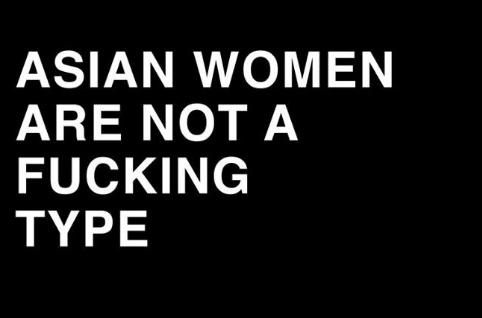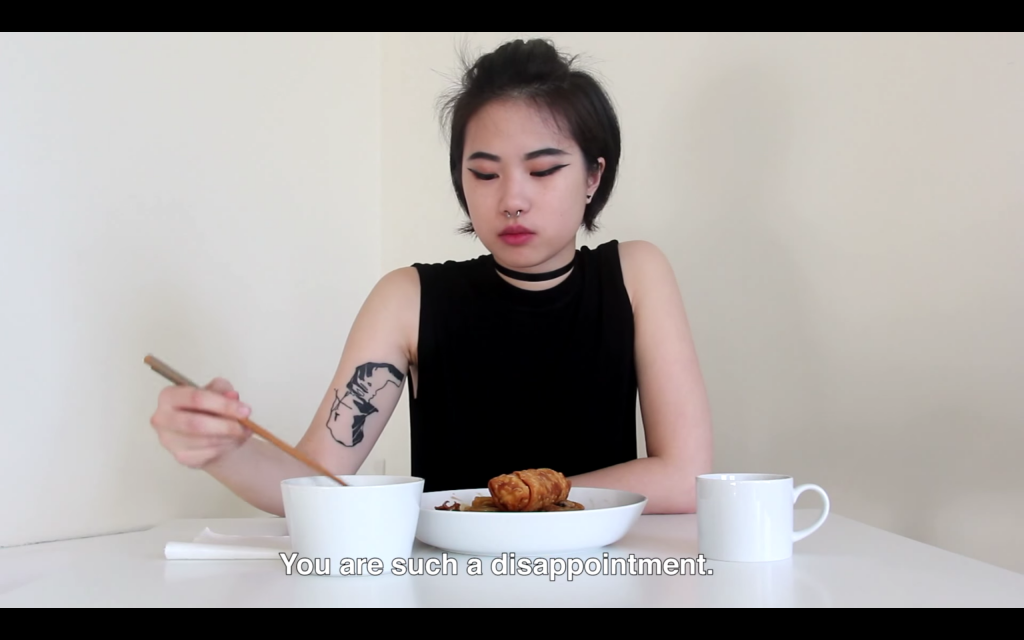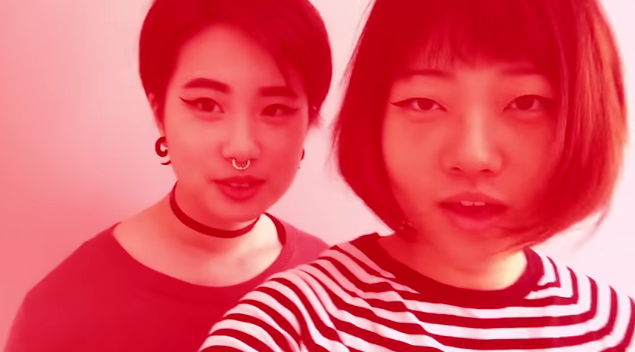Before getting right into the work of SAD ASIAN GIRLS CLUB and some of the ideas and politics behind what SAGC produces, could you tell us a little bit about how you all came together and started this project? Has SAGC kept (relatively) the same members since it was first started? We heard that the members of SAGC currently attend The Rhode Island School of Design. How do you collectively view design as an aid for the aims and politics of SAGC?
Currently we are only Esther Fan and Olivia Park, and it is correct that we are both RISD students. SAGC started after we published our first project, “Have You Eaten?”, and after realizing the impact the project had on its viewers we decided to continue working together as SAGC to make more Asian-female related work. As design students we have the privilege of learning effective means of communication, having access to resources, and being able to receive critique from other designers and professors. When designing our projects, our goal is to keep things simple and straightforward so that our message is communicated directly and clearly to our viewers. As millennials/Gen-Zers, we are also able to incorporate the vernacular and trends of internet/pop culture and know how to reach our audience of other like-minded Asian American women.
Your video ‘Have You Eaten?’ has (in our opinion) a certain dark humor to it. It’s funny and yet relatable to some of us at Hostis and other first generation Asian-Americans who we’ve spoke with and have seen it. In this video what is typically thought of, and experienced, as events within the private sphere is now transposed as an art object for a virtual-public sphere via social media. For that reason, we think it serves as a good example of what SAGC has stated as its principal concern: using aesthetics and art as a means of addressing Asian representation (or lack thereof) in what one might call the ‘public imagination.’ So, given the video’s transposition of the “private” to the “public” was there any discussion regarding how non-Asian-American viewers might receive the video? Namely, was there a sense that while the video would be highly relatable to people who’ve grown up in Asian-American households, the piece also held open the possibility for some viewers to find their prejudices regarding the ‘strict and overbearing Asian parent’ confirmed rather than critique and called into question?
When we made “Have You Eaten?”, we intended our audience only to be those who have had similar experiences and previously were unable to speak out about it in a more serious way than “Shit Asian Moms Say” videos; our project was not intended to be so humorous in that nature. We have certainly received comments from non-Asian viewers voicing their surprise and shock at the way our immigrant mothers spoke to us. However, it is questionable how much productive critique a non-Asian viewer could have offered to the situation in the first place, as the project is not for them.
Consider the varied responses for “Battle Hymn of the Tiger Mother” and similarly shocked and angry responses of non-Asian mothers; many overreacted and considered the author highly abusive, but many Asian readers simply found the book relatable (and also humorous, as some of you did with our project) because these types of relationships between Asian mothers and daughters are nothing new to us. The point of Chua’s book was to show how this stereotypical Asian mother was initially stubborn in her parenting methods but was eventually “humbled by a thirteen year old.”
There was a happy ending for Chua’s story and her daughters still love their mother and were eventually grateful for the way they were raised (or so they say). I believe only Asian readers were able to capture both sides of the book and judge it accordingly; the opinion or commentary of non-Asian mothers became irrelevant because they are unable to relate to it and will likely continue to attempt to confirm their own prejudices towards Asian culture. People who already have opinions about other people typically will see/hear only what they want to see/hear to confirm their preexisting opinions regardless.
It’s worth noting that what’s different about our project from “Battle Hymn of the Tiger Mother” is that for several other Asian women there is no happy ending; not all of us are able to stand up to our mothers or speak out against the way they treat us and potentially damage us mentally. Our project was, again, intended for an Asian audience who could relate to our personal experiences and feel confident that someone will speak up about Asian-related issues when they are unable to or did not feel encouraged to do so. We have considered ways to reach non-Asian viewers or those who are new to concepts regarding social issues; we realized this would require a specific method of educating a new audience. We’ve put this on our to-do list for future projects.
Building off the last question, what are some of the obstacles that you all have come up against in terms of aesthetic interventions in everyday life? Not simply in terms of medium or the range/degree of influence of each art product but also in terms of how SAGC views the efficacy of aesthetic mediums as a means of socio-cultural transformation with regard to the lives of Asian-American women. In other words, and this is perhaps a very old question, what are the limits and merits of political art as SAGC sees it?
There is the issue of the immediate labeling of “social justice warriors” or the stereotypically angry and oversensitive activist that we’ve faced, which often automatically turns off some viewers from our work. But, as mentioned earlier, we’ve decided that those who can’t offer productive critique or opinions regarding political work because they prefer to stick to their preexisting ideas are not people we intend to be in our audience, nor people we make our work for.
We have also discovered other similar art groups such as ourselves in the past that were unfortunately very short-lived for a variety of reasons, which we also keep in mind. It’s easy to make our work trendy and keep up with the aesthetics of pop culture to make our work relevant and relatable, and the extremely fast-paced sharing culture of the internet certainly helps to keep projects alive. However, this also means our audience could lose interest just as fast. You could say that as long as we always tackle the most current and relevant social issues of Asian-American women and remain politically correct in all our actions, the political nature of our work will not die or negatively affect us. But it is always difficult to predict the habits or interests of future audiences. We believe what has caused previously political Asian-American groups to be short-lived was because of the recurring problem of silence and passivity among the Asian community. People get bored, run out of things to be angry about, or decide it is more comfortable to remain ignorant of the unpleasant. Building a lasting community of members/followers also takes consistent investment of time, care, and even money. It takes a good amount of commitment to keep the momentum going. So far, making political work has been a positive and liberating experience for both ourselves and our audience, and we believe the few limitations that come with making work such as ours are usually related to clashing opinions of the maker and the viewer. We don’t know how much this answers your question, but being stereotypical leftist millennial women, we simply need to make sure we stay mindful of our actions and remain open to all critique and cover/acknowledge all relevant issues over time.
 ‘Asian Women Are Not All ____’, Sad Asian Girls Club, 2016.
‘Asian Women Are Not All ____’, Sad Asian Girls Club, 2016.
We were struck by your “Asian Women Are Not ___.” series. Especially the poster that read “Asian Women Are Not All Chinese, Japanese, or Korean.” What was striking about this one in particular is that it suggests that one of the important (and largely overlooked) features of the psychic constitution and everyday lives of Asian-American women are those experiences of misrecognition, followed by the misattribution of another people’s heritage that is then thrust upon the bodies of Asian-American women. Could you tell us a bit about where were these posters hung up and the reactions from the people who saw them?
The statement on the posters were all submissions by our nearby community of mostly East Asian women; the specific poster you mentioned was more referring to the absence of representation for South and Central Asian women and the assumption that “Asian” only consists of Chinese, Japanese, or Koreans. But yes, in general we all face the issue of mislabeling by non-Asian people (usually white) and the misuse and appropriation of elements of our specific cultures.
The posters were stuck up on the side of the RISD library building in downtown Providence. The building faced a highway; drivers on the road and passersby were able to see all of the statements at once in one long row. We weren’t able to document all of the reactions, but the people we witnessed seemed to be either indifferent or amused. One particular experience stuck with us. Esther was making sure all the posters were sticking properly to the building, when a white campus officer pulled over in his car to inquire about the project. After confirming that we had permission to use the building for our installation, the officer mentioned that he could “definitely relate to this project, because my girlfriend is Asian, you see.”

It’s clear to your audience that regarding the experience of first generation Asian-American women (or those who have done the majority of their growing up in the United States) there is a tension between what these women know they are not (not your token friend, not all have small breasts and butts, etc.) and what these women know they are in reality, so to speak. There is a tension, in other words, in the experience of Asian-American women who are made to feel as if they are not from ‘here’ (i.e. United States) and yet simultaneously feel, or understand themselves, as not being from ‘there’ (i.e., the country of our parents origin). It’s kind of like what Samuel Butler termed Erewhon; signifying at once the originary ‘nowhere’ and the displaced, disguised, modified, and always re-created ‘here-and-now.’ Or what the Chicana-dyke feminist, tejana patlache poet, writer, and cultural theorist, Gloria Anzaldua termed the ‘borderlands’ experience. Could we say that the art and design work produced by SAGC is not simply a representation of this liminal space inhabited by Asian-American women but also a way of being antagonistic to those situations where we are made to feel like we are not ‘from here’ while also not being ‘from there’ and therefore not being a ‘real’ Asian; not being a ‘real’ Asian implying some degree of ‘whiteness’ whether desired, strived for, or assumed? Additionally, and on this last point, the fact of being first generation and not white seems to imply that Asian-American women are made to feel some degree of ‘failure;’ that is, one fails at ‘authentically’ being ‘Asian’ and is ‘whitewashed,’ or a ‘banana,’ etc. So is SAGC doing anything currently, or have future plans, to produce something that speaks to this experience of negotiating this double-bind that first generation Asian-American women experience day in and day out?
We ourselves definitely resonate with this tension of a type of identity crisis. We recently have been discussing the model minority myth for a project, which results in the accusation of an Asian being “whitewashed”; this labeling is something we ourselves disagree with.
When someone is not a “real” Asian, this usually means they are not fitting into stereotypes constructed by non-Asian people which, in the “Asian Women Are Not___” project, we emphasized that nobody fully fits into. When someone is called “whitewashed,” this usually refers to the fact that they speak perfect English and have adapted to the habits and lifestyle of a white person; this implies they have somehow abandoned their ethnicity in favor of another, which again condemns the individual for not fitting into Asian stereotypes. This perpetuates the model minority myth, which implies that Asians have “made it” or are more successful than white people and thus they are not only immune to any type of oppression but also implies whiteness is and will always be the only key to success for any person of color. To label one another in America as either an “authentic” Asian or a “whitewashed” Asian is to reinforce the idea that an Asian can only either be put in their place as a foreigner (lower than white) or be the adaptable foreigner who is trying to be successful (white).
What SAGC aims to do, ideally, is to reclaim our identities as Asian-American women; being Asian and American (or raised in a Western society) is and should not be mutually exclusive in this day and age. Regardless of whether one fits into the stereotypes of a “banana” or a “real” Asian, the point is that we emphasize individuality and one’s identity does not have to fit into specific labels or stereotypes of Asian or white, because we as a society have already moved past these labels. Or, since ultimately humans love to categorize one another, one could say the “Asian-American” has become an entirely separate identity of its own.
SAD ASIAN GIRLS CLUB is a duo of female Asian graphic designers aiming to break the culture of passiveness and silence of Asians during discussions of social issues as well as provide more representation for Asian girls of all types and backgrounds. Follow them on Twitter @SADASIANGIRLS and check out their site (sadasiangirlsclub.tumblr.com/) for more info.
HOSTIS is a journal of negation. Fed up with the search for a social solution to the present crisis, it aspires to be attacked wildly and painted as utterly black without a single virtue. Hostis Issue 1: Cruelty is available from Little Black Cart. Hostis Issue 2: Beyond Recognition is forthcoming and will be available soon through Little Black Cart as well. Additionally, Hostis will be publishing interviews with some individuals and groups (e.g. L.A. ONDA, Nina Power) affiliated with the project of reviving the powers of the negative and engaging in nothing short of civil war in the near future. More information can be found at incivility.org.




